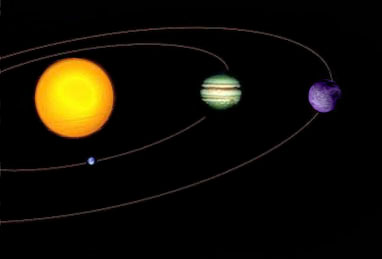






 |
Conclusion
Back to the results
The catalogue also shows the 12 real systems that were
investigated. In the upper and lower graphs (Fig. 4), it is
clear that the unstable regions also correspond to secondary
resonances (see Érdi et al. 2007b), at the mass ratios μ =
0.004 (caused by A 5:1) μ = 0.006 (A 4:1), μ = 0.009 (A
3:1), μ = 0.014 (B 3:1), μ = 0.015 (A 2:1), μ = 0.022,
and μ = 0.01 (B 2:1) between the libration periods of the
Trojan planet. These are the resonances that perturb the
orbits of the Trojan planets and change the size (visible as
gaps in this Figure) of the stable regions.
In this article we concentrated on possible terrestrial
Trojan planets that may stay around the equilateral equilibrium
points of a system consisting of a host star and a
gas giant. We investigated 12 different EPSs in detail and
found that stable regions around these points would allow
planets to move there and to stay there for long times on
orbits of low eccentricity. We can conclude that 7 of the
12 real systems have good initial conditions for habitability;
but in the context of the spectral type of the central
star, we find that HD93083, HD28185, and HD17051 have
even better conditions for habitability of a possible Trojan
planet.
In addition, we compiled a new catalogue of such stable
regions for different mass ratios of the primary bodies (host
star and GG) and different eccentricities of their orbits. We
also determined the stable area by using the results of integrations
for 10^7 periods.
The results (more details see also
Schwarz et al. 2007c) can be used for
any EPSs found in the future to tell the probability of having
a large enough region around the L4 or L5 points to host
terrestrial planets. This new catalogue is especially useful
for single planetary systems when estimating the size of the
stable regions around the equilateral Lagrangian points.We
emphasise that this catalogue is a useful tool, because the
stable regions can be derived be a simple scaling using our
results (see Sect. 4). It may also be important for future
detection of real Trojan planets in EPS via sophisticated
observation techniques from the ground or space.
|
|
















